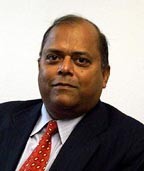Ramesh K. Agarwal | |
|---|---|
 | |
| Born | 1947 (age 77–78) [ citation needed ] |
| Nationality | American |
| Awards | Clarence (Kelly) Johnson Aerospace Vehicle and Design Award[ citation needed ] Reed Aeronautics Award [1] |
| Scientific career | |
| Fields | Computational Fluid Dynamics, Computational Aeroacoustics |
| Thesis | Improvement of Series with Applications to Fluid-Mechanics (1975) |
| Doctoral advisor | Milton Van Dyke |
| Doctoral students | Michael Wendl |
Ramesh K. Agarwal is the William Palm Professor of Engineering in the McKelvey School of Engineering at Washington University in St. Louis. [2] [3] He is also the director of Aerospace Engineering Program, Aerospace Research and Education Center and Computational Fluid Dynamics Laboratory [4] at WashU. From 1994 to 2001, he was the Sam Bloomfield Distinguished Professor and the executive director of the National Institute for Aviation Research at Wichita State University. [5] Agarwal received Ph.D in Aeronautical Sciences from Stanford University in 1975, M.S. in Aeronautical Engineering from the University of Minnesota in 1969 and B.S. in Mechanical Engineering from Indian Institute of Technology, Kharagpur, India in 1968.